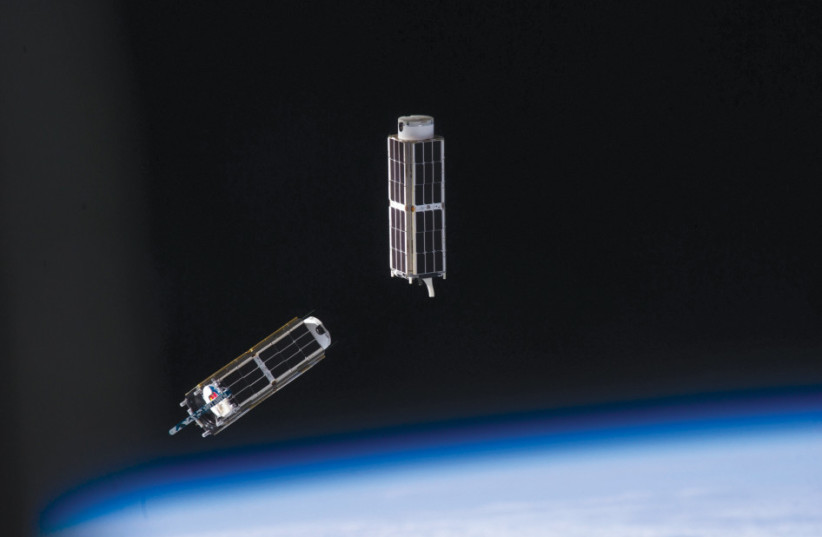After a three-year journey, the Israeli Tevel program has finally taken flight. Corona and NASA-related delays held back the project, which saw Israeli high school students build their very own nanosatellites, launching them into orbit in mid-December.
Spearheaded by the Israel Space Agency and the Science, Technology and Innovation Ministry to promote STEM-education, the program also aimed to encourage a collaborative and peaceful environment among all high school students, regardless of their gender, race, socioeconomic standing, or religious beliefs.
Tevel, which is a Hebrew acronym for Talmidim Bonim Lavyanim (students building satellites), was the very first program of its kind between Israeli and Arab students jointly studying satellite engineering and astronomy, and the agency has other projects planned.
Eight different teams of high school students from across the country constructed their own small satellite, while also studying physics, engineering and astronomy and later writing the satellites’ programming. Finally, in December, the students watched their dreams come true.

The satellites
Following the launch and successful deployment in space, students and teachers are manning two ground stations that broadcast information received from the nanosatellites and are also capable of receiving signals, explained Raz Shteinmaltz, from the Yeroham Science Center, who oversaw one of the eight teams of students. “The entire project – from start to finish – is being done by students. They’ve built these satellites entirely by themselves. It’s pretty revolutionary. We want to train students to become the next generation’s space engineers, and help expand the space sector in Israel. We also want to empower schools and build better educational infrastructure, so that programs like these can continue to train the next generation of space experts.”
The nanosatellites, he explained, have two main components that will be used for communications research. The first piece of equipment is a multi-reflector device, or type of mirror, which is capable of receiving a laser beam from Earth ground stations, and later allows them to “bounce back” to Israel. That project is part of a broader collaboration with Tel Aviv University’s Physics Department.
“This will allow us to develop communications based on lasers, and expand our knowledge in quantum communications.”
Raz Shteinmaltz
“This will allow us to develop communications based on lasers, and expand our knowledge in quantum communications,” said Shteinmaltz.
The nanosatellites also feature rotating solar panels and cooling fins to enable their travel – with very little fuel – around the Earth. The second instrument onboard is a transponder, which will help radio stations communicate with one another by receiving a signal from one side of the Earth and transferring it halfway around the world by means of radio waves.
The ground stations are based in the Negev desert region of Yeroham and suburban Herzliya. The students, he noted, have been trained to broadcast and receive signals from the stations on their own. “The satellites pass above Israel between two and three times a day, and we receive and send them signals or messages during those times,” Shteinmaltz said.
Israeli high school students who majored in engineering and physics were able to participate in the Tevel program. “We trained them how to operate space systems,” said Shetinmaltz, with the assistance of the Herzliya Science Center.
The Herzliya center has already seen students and teachers send the Duchifat (hoopoe) 1, 2, and 3 nanosatellites to space in 2019. But for the students of the Amit B’Levav Shalem Yeshiva High School, this was simply part of another homework assignment.
“Yeroham is also one of the best places to view the stars,’’ Shteinmaltz explained, as the desert atmosphere has very little light pollution. Every summer, droves of Israelis camp nearby to watch the famous Perseid Meteor Shower. Neither is there electromagnetic interference, which helps the Yeroham ground station outperform its counterpart in Herzliya.
Or Porat, a former student of the Ulpanat Amit girls high school in Givat Shmuel, was one of those students. When Porat’s teacher informed her class that they would be building a satellite, she thought he was “speaking gibberish,” she laughs. “I didn’t understand what he was saying, but it sounded exciting.”
While she pursued a physics track in high school, the material the class had to learn wasn’t basic mechanics. Subjects such as satellite hardware and C-language programming were crammed into an Israeli high school girls’ already-packed schedule. And when things went wrong or the technology malfunctioned, the girls would stay late after school, and calmly fix and resolve the issues.
As for the Tevel constellation, it will continue to rotate the Earth hopefully for the next five years. Eventually, the effects of low gravity will make the tiny satellites burn up in the atmosphere, becoming no more than stardust. But that doesn’t worry Porat. “We built something amazing,” she said.
One of the most inspiring moments of the program wasn’t merely the launch – which some students watched live at NASA’s facilities – but the collaborative atmosphere that was behind this coming-of-age constellation. “I met people who I thought I’d never meet,” Porat said with a smile. “I still have some friends who I’ve stayed in contact with even though the program is over.” She recalled how all the students worked together, regardless of race, religion, or gender.
Now done with high school, Porat is completing her national service at Soroka-University Medical Center as a doctor’s assistant conducting blood tests, and claims that Tevel really opened up her eyes to science.
“It gave me the tools to actually understand technology,” Porat said. “I want to be a doctor when I grow up.”
And while the men in her family work in technical fields, building the nanosatellite convinced Porat that she could reach for the stars too. “This program opened my eyes to pursue something I never would have considered before.” ■
